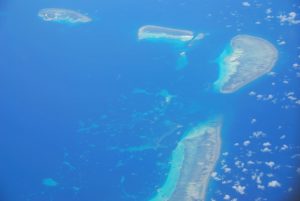The annual “high sea joint training formation” of the People’s Liberation Army (PLA) Navy in its southern theater returned to the Zhanjiang Naval Base in Guangdong this year. This “normalized” formation crossing seas exercise started in 2018, beginning after every New Year and enduring over the Chinese New Year. So what is different in this year’s exercise from those held in the previous years? Have the degree and difficulty of drills improved? These are key questions that must be answered.
On February 9, three days before the Chinese New Year, the PLA Navy expressed appreciation for and recognition of the formations under the naval mission in the Zhanjiang Naval Base, the garrison at the Nansha Islands (Spratly Islands), and the support base in Djibouti via satellite connections. As to the formations under the naval mission, there is the 37th escort formation to the Gulf of Aden, the 36th escort formation returning from the mission, and the 175th formation.
The pennant number of Type 052D Missile Destroyer Yinchuan is 175. According to the practice of PLA Navy, the formation is named after the pennant number of the flagship. Therefore, the flagship of this year high seas joint training formation is the Yinchuan, leading 568 Hengyang (Type 054A Frigate), 967 Chagan Lake (Type 901 Integrated Replenishment Ship), 987 Wuzhi Shan (Type 071 Integrated Landing Ship), and 857 Tianshu Star (Type 815A Electronic Reconnaissance Ship).
The scale of this formation had been finalized at the first Zhanlan-2018A formation used in the 2018 exercise. It combines a 052D destroyer and a 054A frigate into a “High/Low Mix” of a large and smaller ship. Instead of a Type 901, it was a 903A integrated supply ship in 2019. Since 2020, it has turned to Type 901, whose displacement has been doubled and is mainly responsible for replenishing aircraft carriers.
The Type 071 and Type 815B’s participation in crossing the first and second island chains have been hard to understand. In this year’s exercise, from the command team staff’s armband, chest badge and camouflage training uniform, visible via the CCTV coverage of the command post of the exercise, it could be identified that the staff includes the Strategic Support Force and Rocket Force. This explains why this high-seas training formation has been noted as “joint” since 2019 and uses the formation it does.
This year’s edition is similar to that in 2020. In the anti-terrorism and anti-piracy exercise, 130mm guns, Type 1130 CIWS (close-in weapon systems), and infantry weapons were used to fire at surface targets according to their separate ranges. The drones simulated a multi-directional saturation attack in the air defense and anti-missile exercise. The HQ-10 short-range air defense missiles and Type 1130 CIWS served as interception. However, the exercise demonstrated the PLA Navy’s capabilities of sea control and air defense. The lack of anti-submarine exercises, coordinating this formation with shipborne Z-9 helicopters and Type 052D equipped with active and passive towed array sonars, implies that PLA Navy is yet to strengthen its skills in this direction or is short of confidence on this subject.
What is surprising in the official film of the PLA Navy on the exercise, is that after the formation entered the South China Sea, we could find the 989 Changbai Shan (Type 071 Integrated Landing Ship) newly merged into the formation and 987 Wuzhishan loaded with Type 726 Air-cushion Landing Craft of PLA Navy Marine Corps, which combined with army combat vehicles carried on 989 Changbai Shan to coordinate with Z-8 transport helicopters rappelling marines for conducting landing exercises.
From the wide landscape behind the ZTZ-96 main battle tank: Subi Reef, Fiery Cross Reef and Mischief Reef are all lined with buildings and whose shores are all along consolidated with tetrapods; therefore, they were not the landing location. Instead, comparing the relative positions of shore paths and bunkers, the landing location seems to be the Pattle Island in the Paracel Islands group. The purpose behind this choice, as the official media could reveal, is that it demonstrates the long-range attack capability of Marine Corps.

































